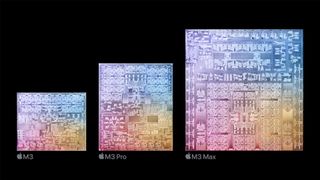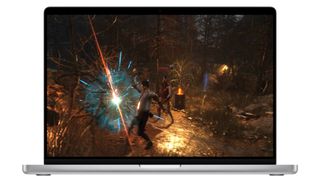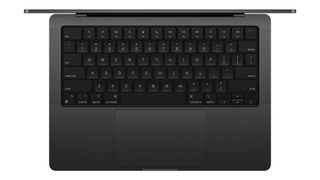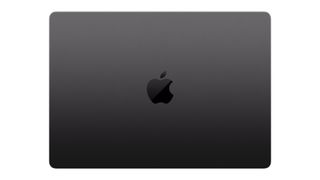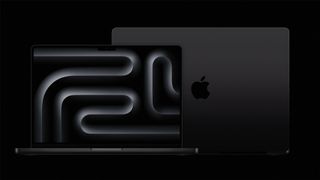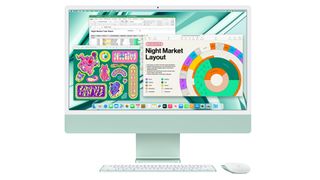Apple does the unthinkable with three new M3 chips, new MacBook Pros, and, yes, a new iMac 24 – and that’s not even the biggest news
Apple is closing out its 2023 product year with what may be its biggest reveal on the smallest scale. Today, the Cupertino tech giant announced not one, but three new pieces of Apple silicon, all under the name M3.
Along with three new chips – delivering them all at once is a first – Apple unveiled a collection of new MacBook Pro laptops running them and a resuscitation of the somewhat dormant iMac during a livestream on Monday evening (the pre-Halloween ScaryFast Event). line with a new iMac 24-inch with the baseline M3 chip.
As for scale, the M3, M3 Pro, and M3 Max are all 3-nanometer process SoCs that bring better efficiency and a major and potentially even game-changing GPU improvement called Dynamic Caching.
I got an early look at the new systems running the all-new Apple Silicon, and yes, the story is to some extent about a new line of MacBook Pros that now range between 14 and 16 inches (goodbye 13-inch M2 MacBook Pro) and the latest iMac 24-inch. However, Apple hasn’t redesigned any of the hardware. The MacBook Pro, for example, is virtually unchanged except for one ionic color (more on that later).
What matters here is the chip. It’s been three years since we saw the first collection of Macs running Apple’s Silicon. The MacBook Air, MacBook Pro 13 inches and the Mac Mini heralded Apple’s rapid departure from the x86 Intel world to a SoC platform of its own making.
Despite being Apple’s first attempt at desktop and laptop-quality silicon, these systems were critically acclaimed and Apple had similar success with virtually every Apple silicon variant released since, including the M1 Max and M1 Ultra. Some may argue that the M2 wasn’t enough of a generational leap, but Apple seems intent on erasing that impression with its M3 chips.
Unlike the M1 and even the M2, where we waited months for core options, the M3 arrives with a full range of core and performance variations (without an expected M3 Ultra). Like the M1 and M2 before it, the base M3 has an 8-core CPU and 10-core GPU. The M3 Pro starts with 12 CPU cores and an 18-core GPU, and the M3 Max has a 16-core CPU and a 40-core GPU (the M2 Max topped out at 38 cores).
While the core proportions aren’t much different from the last Apple Silicon, Apple promises a generational leap when it comes to performance. There is greater efficiency thanks to the 3-nanometer process and general improvements over the original M1 chip. The speed improvements may be more incremental when it comes to comparisons with the M2 class.
At the highest level, the M3 Max supports up to 128GB of unified memory, meaning the new MacBook Pro will almost certainly be the best mobile workstation on the market. Not only is the memory on these M3 systems unified, but there is also no separate graphics option. Apple’s SoC does it all and can even beat the performance of AMD’s last discrete MacBook Pro option.
However, there is an important wrinkle here. Apple’s M3 silicon (any version of the series) comes with a new form of GPU memory architecture with what Apple calls ‘Dynamic Caching’, which, if it works as advertised, could change the way M3 MacBook Pros handle gaming and rendering tasks to carry out.
Dynamic caching turns traditional graphics memory management on its head. For example, instead of the system architecture looking at the most memory-intensive task and then allocating the same amount of memory to each similar task, the hardware looks at each task individually and then applies only the appropriate amount of memory.
This could make M3 systems much more efficient and speed up performance by opening up memory for other tasks.
Perhaps the best part of Dynamic Caching is that developers don’t have to write new code to take advantage of it. It will just work.
The M3 chips will combine lower power consumption and memory efficiency with hardware-accelerated ray tracing and mesh shading (both of which have an impact on realism in gaming graphics). The Neural Engine is reportedly 60% faster than what was found in the M1 chip class. It is not yet clear what the speed difference is between M2 and M3.
All this performance and efficiency doesn’t equate to longer battery life than Apple Silicon has achieved with the M2 class. It’s still a significant 22 hours of video and about 15 hours of web browsing (the system supports fast charging to get a 50% charge in 30 minutes). The good news here is that you’ll likely see performance improvements without sacrificing battery life.
The new M3 chips will be housed in a new MacBook Pro range that, with a few exceptions, looks a lot like the M2-class MacBook Pro.
But first, Apple is finally putting the MacBook Pro 13-inch with Touchbar out to pasture. The MacBook Pro line now starts with a 14-inch model.
This means that the base MacBook Pro M3 is more expensive at $1,599 than the smaller $1,299 MacBook Pro 13-inch with M2. However, it is also cheaper than the MacBook Pro 14-inch with M2. All models now start with 512GB base storage, and the M3 Pro and M3 Max can support up to 128GB of unified memory.
In short, you get more for less, but the bar for entry into the MacBook Pro excitement is now a little higher.
You could argue that it simply makes more sense to start the Pro line at 14 inches, but many people have hooked up these portable workhorses to external displays. At that point, the screen size of the laptop becomes slightly less important. Perhaps Apple is looking for a clearer delineation between the MacBook Pro line and the MacBook Air, which still starts at 13 inches (and doesn’t have 14- or 16-inch options), and uses M2-class Apple Silicon for now.
Not every new MacBook Pro gets all M3 options:
The MacBook Pro 14 is available with the M3, M3 Pro or M3 Max.
The MacBook Pro 16 is available with M3 Max or M3 Pro.
Apple didn’t redesign the MacBook Pro. Due to some component changes, the weight is slightly different (I lifted a MacBook Air 13-inch and didn’t find the 3.4-pound weight to feel particularly heavy or light).
Everything from the Liquid Retina There are still three Thunderbolt USB-C ports (only two on 14-inch M3 models).
What’s different is the new Space Black finish. I have seen this finish in person and it is dark, brooding and beautiful. But the color is more than skin deep. Apple has used a new anodizing process that makes the laptop’s body fingerprint resistant. I can report that no matter how hard I tried, I couldn’t leave my fingerprints on the finish line.
While I got an early look at all the systems running on the new M3 silicon, my impressions are in no way definitive. That said, the M3’s performance looks quite impressive across a range of tasks, including editing multiple 4K streams, analyzing an MRI brain scan, vertically slicing a 3D architecture model like a giant pie , so you can walk through layers of walls and floors at the same time. , and numerous game demos for consoles, including the new one Lies from P. Overall, the demos proved to me what I’ve known for a while: Apple Silicon was coming to play.
Apple is also breathing new life into the semi-dormant iMac line with a new M3 iMac 24-inch. As with the MacBook Pro line, aside from obvious component differences, the hardware here is unchanged from the M1 iMac 24-inch that Apple launched a few years ago (including the lighting cable-friendly keyboard and trackpad peripherals). For now, there are no M3 Pro and Max options for the iMac, and Apple isn’t talking about a 27-inch model either.
However, there are two core options. The 8-core M3 iMac 24-inch starts at $1,299 and the 10-core model starts at $1,499.
I saw a handful of iMac 24-inch demos where the M3, as on the MacBook Pro, performed well. It’s a wonderfully large screen for video editing and multitasking. gaming (Myst, mainly shows off the M3’s ray-tracing skills). There are no new color options for the iMac.
Ultimately, the new MacBook Pros and All-in-One iMac 24-inch serve as a showcase for Apple Silicon’s advancements. They may not be massively faster than what you bought earlier this year in your M2 MacBook Pro, but for those who still own an M1 system, or even an Intel MacBook Pro that’s on its last legs, this can feel like discovering of a new world of performance. Apple is clearly betting on that. Of course, we’ll know more after we put these components and systems through our own testing.

